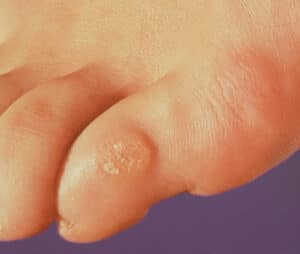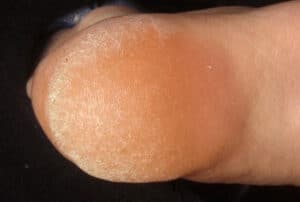Corns are hard and thick layers of skin that appear when the skin tries to protect itself from friction and pressure. They almost always form on the fingers or toes. Corns and calluses can be unpleasant.
If you are a healthy person, you only need treatment for corns if they cause you discomfort. For most people, simply eliminating the source of friction or pressure causes corns to disappear.
If you have diabetes or any other disease that decreases blood circulation to the feet, you have a higher risk of complications from corns. Ask your doctor about proper care of corns if you have any of these diseases.
You could have a corn on the foot if you observe:
- An area of thick and hard skin
- A hard and raised bump
- Sensitivity or pain under the skin
- Waxy, dry or flaky skin
Corns and Calluses are not the same:
- Corns are smaller than calluses and have a hard center surrounded by inflamed skin. Corns usually appear on the part of the feet that does not support weight, such as the tips and sides of the fingers and even between the toes. They can also be found in points that support weight. Calluses can be painful when pressure is placed on them.
- Calluses are rarely painful. In general, they form on the soles of the feet, especially under the heels or the metatarsal region, on the palms or on the knees. Calluses vary in size and shape, and are often larger than calluses.

When to consult the doctor?
If corn or callus becomes very painful or inflamed, see your doctor. If you have diabetes or poor blood flow, call your doctor before treating a callus or calluses on your own, as even a small foot injury could cause an infected open wound (ulcer).
Corn Foot, Risk factor’s
The following factors may increase the risk of corns and calluses:
-
- Bunions. A bunion is an abnormal bone bump that forms in the joint at the base of the big toe.
- Hammer toe. Hammer toe is a deformity in which the toe bends like a claw.
- Other foot deformities. Some conditions, such as osteophytes, can cause a constant rubbing inside the shoe.
- Do not protect your hands. Use Hand tools without gloves expose the skin to excessive friction.
Corn Foot Prevention
The following approaches can help you prevent corns and calluses:
- Wear shoes that have ample room for your fingers. If you can’t move your fingers, the shoes are very tight. Ask a shoemaker to stretch them on the part that they squeeze or prick you.
- Use protective coatings. Use felt templates, non-medicinal callus templates or bandages on the places where the shoes squeeze you. You can also try toe separators or put some sheep wool between your toes.
- Wear padded gloves when using hand tools. Or, try coating your hand tools with tape of fabric or with some coating.
